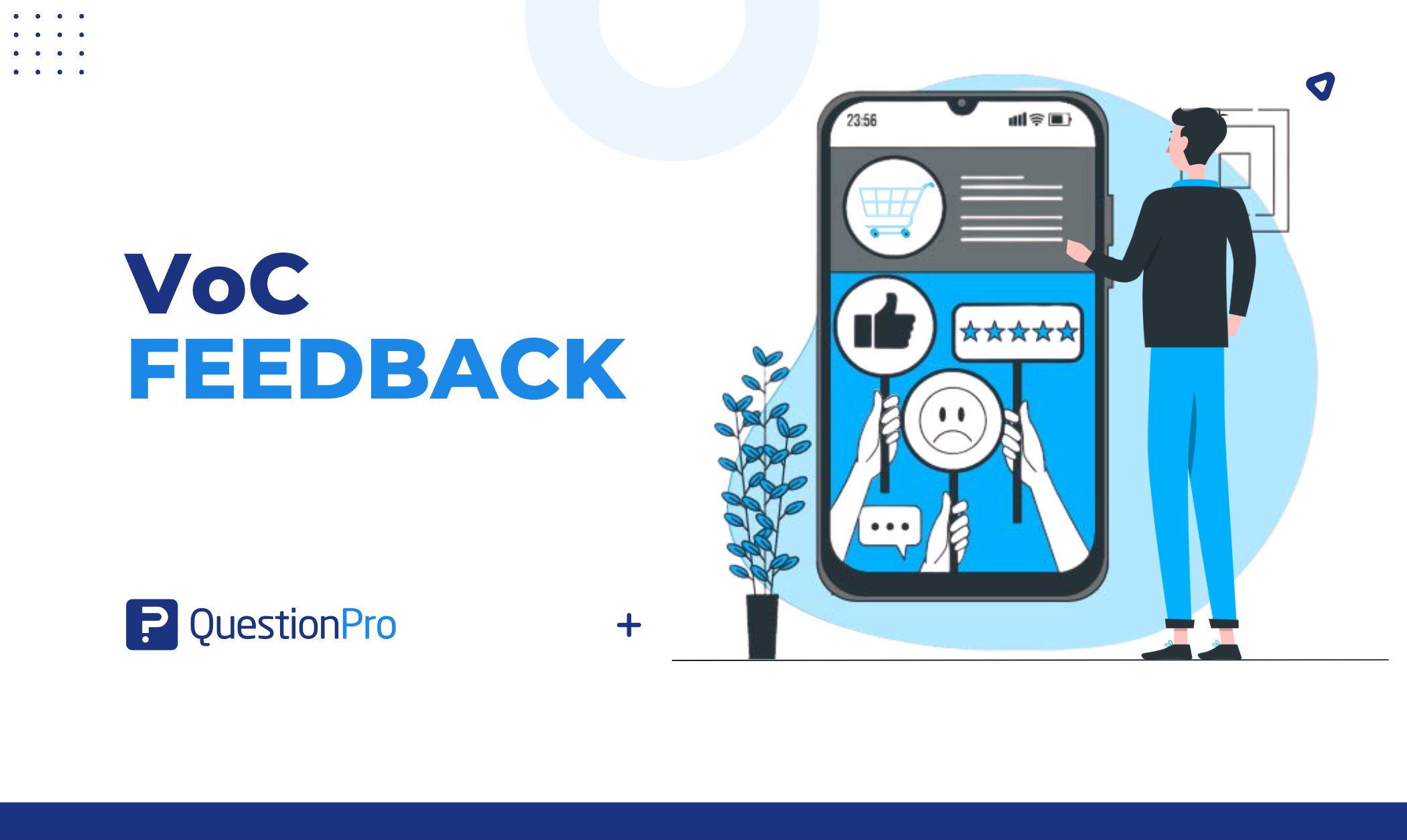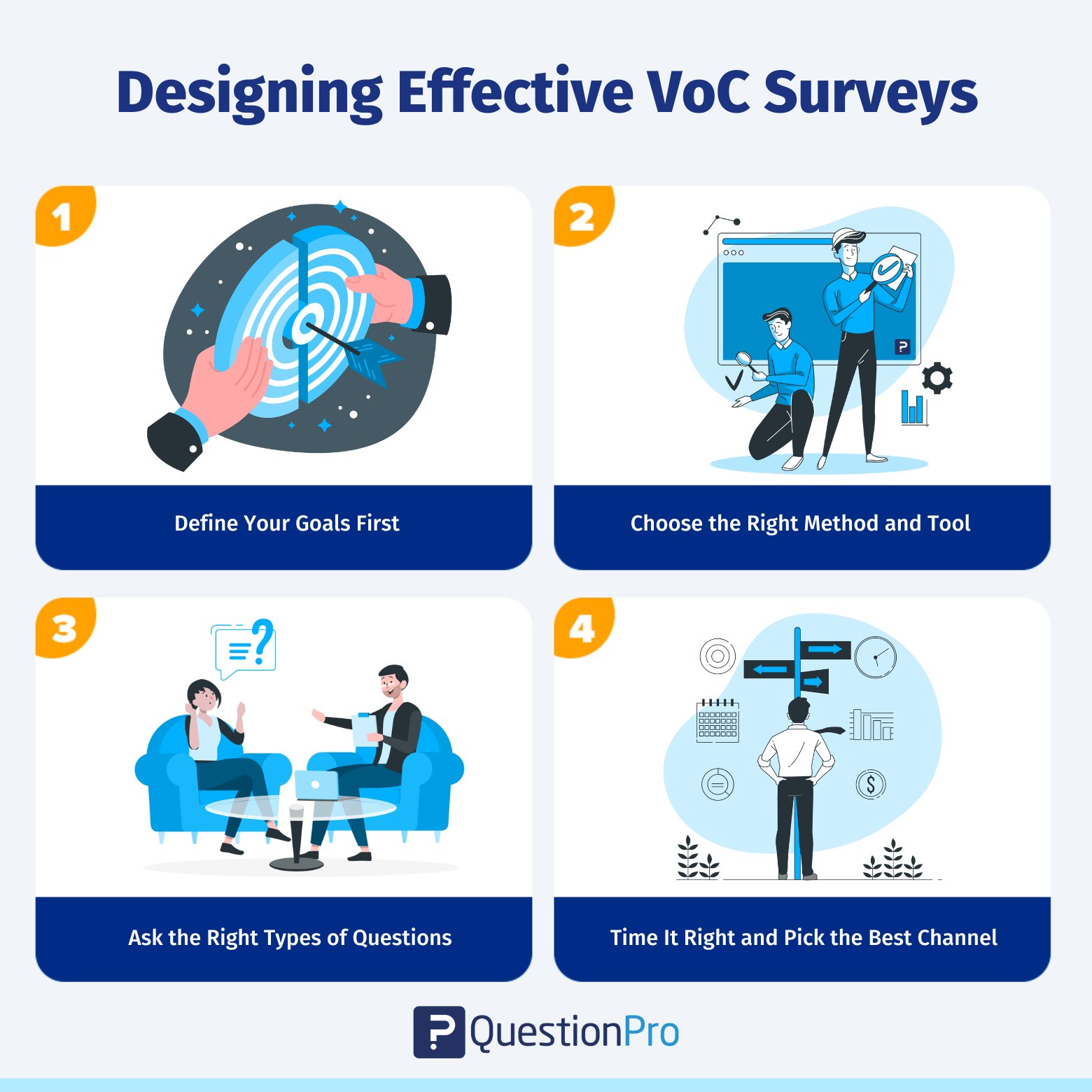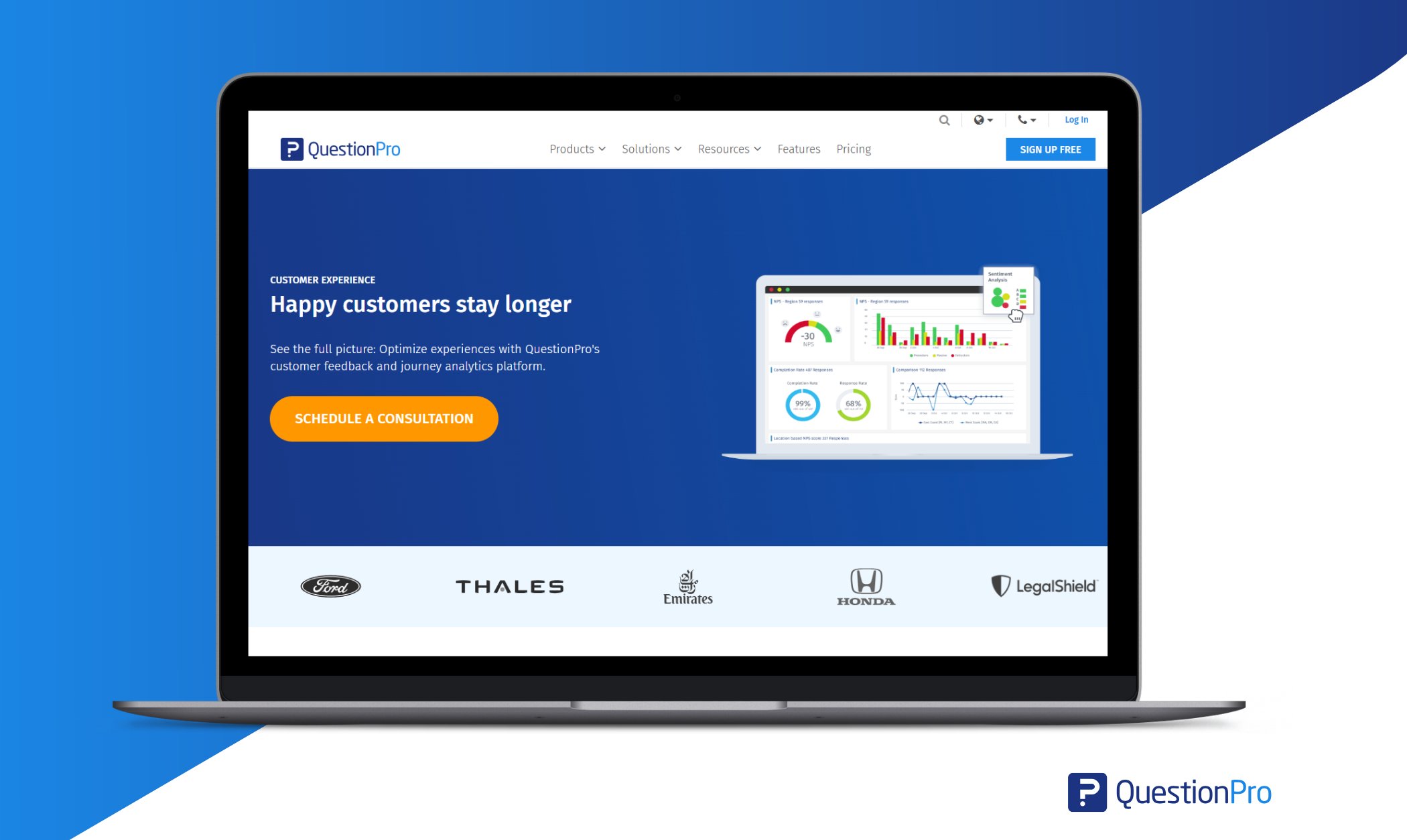
As customer expectations continue to evolve, understanding what your customers truly think is essential, not optional. VoC feedback, or Voice of the Customer feedback, gives powerful insights, so you can improve your products, services, and overall customer experience.
And at the core of every successful VoC program lies one simple yet effective tool: the survey. Whether it’s a quick satisfaction check or a detailed research questionnaire, surveys are the most scalable way to capture feedback that drives real change.
In this blog, you’ll learn about VoC feedback, what it is, why it matters, how to collect it, and how to design surveys that people actually answer.
What is VoC Feedback?
VoC feedback is any suggestion, opinion, or comment that customers share with a business. These insights matter because today’s customers are willing to pay more for an excellent experience, and they won’t hesitate to switch if you fail to deliver.
VoC feedback becomes a structured, scalable way in surveys and research to understand customer sentiment. By asking targeted questions, you can consistently gather, measure, and compare feedback over time.
Remember, your customers know better than anyone what they like and dislike. Ignoring their voice is a missed opportunity to strengthen trust and loyalty.
Why VoC Feedback is Important for Business Growth
As businesses shift toward a customer-centric model, listening to customers has become essential, not optional. VoC feedback plays a critical role in helping organizations align their products, services, and strategies with actual customer needs.
According to research, just 36% of companies have successfully implemented a VoC strategy, leaving plenty of opportunity for others to lead by listening. Here’s why VoC feedback is so important:
- The power has shifted to customers
Today, customers hold the cards with their expectations and demands.
- It’s no longer just about product and service quality
Success now depends on how well you meet customer needs and expectations.
- VoC feedback captures authentic customer insights
Through surveys and research, businesses can gather direct input on how customers feel, what they want improved, and what drives their loyalty.
- It enables a deeper understanding of customers
You can see what truly matters to customers across their entire journey.
- It supports experience design across the customer journey
By collecting VoC feedback at multiple customer touchpoints, you can craft experiences that truly resonate.
VoC feedback gives businesses a direct line to what customers really think. When captured effectively through surveys and research, it becomes a powerful engine for continuous improvement, loyalty, and growth.
Also Check: 5 Best Practices on How to Strengthen Your VoC Program
How to Use VoC Feedback to Improve Customer Experience
Collecting VoC feedback is just the first step. The real value comes when you take those insights and use them to make improvements that truly matter to your customers. Here’s how to turn feedback into real improvements:
- Understand what your customers really want: Capture their needs, expectations, and how they truly feel about your product or service.
- Spot and fix what’s not working: Identify and resolve pricing issues, usability flaws, or poor support experiences.
- Improve your customer experience strategy: Use customer insights to design smarter, more customer-focused strategies.
- Learn from real stories: Hear honest, unfiltered comments that show what’s working, what’s not, and why customers leave or return. Open-ended feedback makes this very clear.
- Measure customer satisfaction: Track key metrics like Net Promoter Score (NPS), Customer Satisfaction (CSAT), and Customer Effort Score (CES) to see how you’re doing over time.
Honest feedback, including the not-so-glowing reviews, can help you grow. That’s why a good VoC survey doesn’t just aim for compliments, it asks the real questions.
When you ask real questions like “Is this product easy to use?” or “Do you feel it’s worth the price?”, you get answers that guide real improvements.
How to Collect VoC Feedback: Methods and Examples
Collecting VoC feedback is all about making it easy and natural for customers to share their thoughts and opinions. Whether you’re launching a new product, improving service, or just want to understand your audience better, the right methods will help you gather insights that actually mean something.
Here are the most effective methods:
1. Surveys (Your Go-To Tool)
Surveys are one of the most effective and scalable ways to collect structured VoC feedback. You can use a survey platform like QuestionPro for your survey.
- Use short, targeted surveys to ask specific questions about a product, service, or experience.
- Include a mix of closed-ended and open-ended questions.
- Send them at key touchpoints, such as after purchase, after support interactions, or even after a customer has churned.
QuestionPro Tip: Use tools that let you customize survey logic and analyze results in real time.
2. Customer Interviews and Focus Groups
If you want deeper insights, nothing beats a real conversation.
- Interviews let you explore customer motivations, frustrations, and expectations in detail.
- Focus groups help you see group dynamics and how people react to ideas or experiences collectively.
Use these for product development, feature prioritization, or understanding user behavior.
3. Feedback Widgets on Your Website or App
Make it easy for customers to share thoughts in the moment.
- Add pop-up questions or feedback buttons on product pages or in-app.
- Keep it quick and focused:
- “Was this page helpful?” or
- “How would you rate your experience?”
4. Post-Transaction and Support Feedback
One of the most effective VoC feedback methods is collecting input immediately after a transaction or support interaction has occurred. This timing ensures the experience is still fresh in the customer’s mind, leading to more accurate and honest responses.
Consider asking questions after a customer makes a purchase or contacts support, and send a short follow-up survey. Ask how satisfied they were, and what you could have done better. Focus on key questions like:
- How satisfied were you with the experience?
- What could we have done better?
Collecting post-transaction and support feedback helps you capture real-time insights when the experience is fresh in the customer’s mind. This feedback allows you to identify gaps, improve service quality, and build stronger relationships.
5. Social Media and Online Reviews
Customers often share their experiences publicly, even if you don’t directly ask for feedback. That’s why social media and online reviews are powerful sources of VoC feedback.
Monitor platforms like Facebook, X (formerly Twitter), LinkedIn, Google Reviews, and industry-specific forums to track mentions, comments, and customer reviews. These channels provide unsolicited, real-time insights into what people think about your brand.
Use sentiment analysis tools to:
- Identify trends in customer opinions
- Detect common concerns or recurring issues
- Understand customer sentiment at scale
By actively listening on social channels, you can address problems early, celebrate wins, and refine your customer experience based on real conversations happening every day.
6. Use Existing Data
Sometimes, the feedback is already there; you just need to connect the dots.
- Analyze support tickets, chat logs, NPS, or CSAT data to uncover patterns.
- Combine this with survey data for a more complete view.
Collecting VoC feedback isn’t just about asking questions; it’s about asking them at the right time, in the right way, and through the right channels. When you listen actively and consistently, your customers will tell you exactly how to make their experience better.
How to Design Effective VoC Surveys That Customers Will Answer
A great VoC program starts with a well-designed survey. But not just any survey, one that’s thoughtful, relevant, and aligned with what you actually want to learn from your customers. Here’s how to design VoC surveys that lead to meaningful insights (and real improvements).

1. Define Your Goals First
The first step to creating VoC surveys that customers will actually answer is having a clear purpose. Before writing a single question, ask yourself:
- What do I want to learn from this survey?
- Am I trying to measure satisfaction, understand pain points, test a new feature, or collect open-ended opinions?
Clear goals help you stay focused and avoid asking irrelevant or vague questions. The more specific your objective, the more useful your insights will be.
2. Choose the Right Method and Tool
Not all VoC surveys are created equal—different situations call for different methods. Select the approach that best fits your feedback goals and customer touchpoints:
- Email Surveys: Ideal for post-purchase follow-ups, NPS tracking, or gathering overall satisfaction feedback.
- Website Pop-Ups: Great for capturing feedback in real time while customers browse or interact with your site.
- In-App Surveys: Perfect for collecting product or feature-specific insights while the experience is fresh.
QuestionPro Tip: Use a platform like QuestionPro, which gives you the flexibility to build, distribute, and analyze VoC surveys all in one place. It also integrates with CRM and analytics tools, helping you connect feedback to real customer data.
3. Ask the Right Types of Questions
The way you frame your survey questions can make or break the quality of your VoC feedback. If questions are too vague, biased, or repetitive, customers may skip them or worse, abandon the survey altogether.
To get meaningful insights, you need a balanced mix of question types that capture both quantitative and qualitative data. Here are the most effective question types to include in your VoC survey:
- Likert Scale Questions: Perfect for tracking trends over time. It measures satisfaction, agreement, or likelihood on a 1-5 or 1-10 scale.
- “On a scale of 1 to 10, how satisfied are you with your recent purchase?”
- “How likely are you to recommend our product to a friend? (0 = Not likely, 10 = Extremely likely)”
- “Rate your agreement: ‘The product was easy to use.’ (Strongly Disagree to Strongly Agree)”
- Open-Text Questions: Give customers space to explain their thoughts in their own words. This uncovers deeper insights and ideas you might not have thought to ask.
- “What did you like most about our service?”
- “What could we do better to improve your experience?”
- “Is there anything else you’d like to share with us?”
- Multiple-Choice Questions: Quick to answer and easy to analyze. Use them for identifying preferences or common behaviors.
- “Which feature do you use the most?”
- Dashboard
- Reporting Tools
- Support Chat
- Account Management
- “What was the main reason for your visit today?”
- To purchase a product
- To ask a question
- To get support
- Just browsing
- “Which feature do you use the most?”
QuestionPro Tip: Avoid overloading your VoC survey. Keep it short, relevant, and focused on your goals. Mixing question types creates a better customer experience and gives you richer data for decision-making.
Learn More: Complete guide to types of questions and sample question types with examples.
4. Choose the Right Time and Channel to Collect VoC Feedback
When and where you ask for VoC feedback can greatly influence the quality and honesty of customer responses. Timing and delivery matter just as much as the questions themselves.
Here’s how to get it right:
Right Time = Fresh Experience
- After a Purchase:
Send a quick satisfaction survey to capture immediate reactions about the buying process.
Example: “How satisfied are you with your recent purchase experience?”
- After a Customer Support Interaction:
Follow up right after a customer support call or chat to assess how helpful the interaction was.
Example: “Was your issue resolved to your satisfaction?”
- After Using a New Feature:
Use in-app micro-surveys to gather feedback while customers are actively using a new tool or feature.
Example: “How useful did you find the new dashboard update?”
Right Channel = Customer Comfort
Pick the channel that aligns with your customer’s behavior and the context of their interaction:
- In-App Surveys
- Website Pop-Ups
- SMS Surveys
QuestionPro Tip: Meet customers where they are. The more convenient and timely your VoC survey is, the more likely they’ll respond—and the better quality feedback you’ll get.
Designing an effective VoC survey is all about putting the customer at the center of the experience. Ask the right questions, at the right time, in the right way, and you’ll get feedback that actually helps you move forward.
Next Read: Best Voice of the Customer (VoC) Software & Tools
How VoC Feedback Drives Real Business Change
Gathering insights is just the beginning. The real action happens when you act on what your customers are telling you. But here’s the catch: many organizations collect feedback but do nothing with it.
Why? Usually, it’s because no one takes ownership or feels responsible for following up. That’s why it’s so important to turn VoC into a team effort. Here’s how to make VoC feedback truly drive change:
Step 1: Organize the Feedback
Use a reliable survey platform that lets you easily collect, analyze, and segment feedback. Make sure it integrates with your CRM or other systems so you can link responses to useful customer data, like industry, product type, or location.
Group similar comments and look for patterns. For example:
- Are multiple people reporting the same issue?
- Is there recurring feedback about a specific feature?
Organizing feedback by topic helps you spot trends and makes it easier to track your progress when you take action.
Step 2: Assign Ownership To Lead
An effective VoC survey doesn’t stop at data collection—it sets the stage for real change. Before you even send out your survey, plan for how you’ll act on the feedback you receive.
One of the biggest mistakes companies make is gathering insights but not following up. Often, it’s because no one is clearly responsible for turning feedback into action.
How to Avoid This?
- Assign Ownership in Advance: Decide who will handle each category of feedback. For example:
- Product Team: Handles feature requests and usability issues
- Customer Support Team: Resolves service-related concerns
- Marketing or CX Team: Manages satisfaction trends and loyalty insights
- Give Teams Access to Data: Make sure responsible teams can view and analyze the survey responses relevant to them.
- Track Progress: Use follow-up surveys (like NPS or CSAT) to monitor improvements after changes are made.
Step 3: Take Action Properly
This is the most important step. If customers take the time to share their thoughts and you ignore them, they’ll stop bothering you, and worse, they might leave.
For small fixes, a quick tweak might be all it takes. But for bigger issues, you may need to rethink processes or even overhaul parts of your product. Either way, take the insight seriously. And always close the loop.
Step 4: Always Say Thank You
Whether feedback is positive or negative, respond with a simple message:
Thanks for your feedback, we’re listening.
This shows customers that their voice matters and someone is actually paying attention.
Step 5: Have the Tough Conversations
If someone leaves a harsh comment, don’t ignore it. Reach out. A quick chat to understand their frustration can turn an unhappy customer into a loyal one. People appreciate it when you take the time to truly listen and fix things.
Collecting VoC feedback is only half the job. What you do with it is what really counts. When you act on insights, assign responsibility, and keep the conversation going, you don’t just improve your product; you build stronger relationships with your customers. And that’s where real change begins.
Why QuestionPro is the Best Platform for VoC Feedback Collection
If you’re looking to launch or upgrade your Voice of the Customer (VoC) program, QuestionPro gives you everything you need to collect, analyze, and act on feedback without the tech headaches. Here’s what makes it a standout choice:

- All-in-One Platform for Survey Design, Distribution, and Analysis
From building smart surveys to distributing them across email, web, and in-app, and analyzing responses in real time, QuestionPro simplifies the entire VoC process under one roof.
- Ready-to-Use VoC Survey Templates
No need to start from scratch. QuestionPro offers pre-built VoC templates for collecting customer expectations, product feedback, and service experiences so you can get started quickly and ask the right questions.
- Built-In Text and Sentiment Analysis
Don’t just collect feedback, understand it. Open-ended comments are automatically analyzed using text analytics and sentiment tagging, helping you spot trends and prioritize issues faster.
- CX-Specific Features That Drive Action
Designed with customer experience (CX) in mind, QuestionPro includes:- NPS, CSAT, and CES tracking.
- Real-time dashboards for different teams.
- Closed-loop feedback workflows to ensure follow-up.
- Advanced Reporting with Emotional Intelligence
Go deeper with layered insights. QuestionPro’s sentiment tools don’t just count keywords; they detect emotion, intent, and satisfaction levels across different touchpoints in the customer journey.
QuestionPro helps you not only hear, but also understand and act on the voice of your customers at every level of your organization.
Conclusion
Voice of the Customer (VoC) feedback is no longer a bonus; it’s a business necessity. Customers today expect to be heard, and more importantly, to see their feedback lead to action. We learned about VoC feedback, VoC surveys, how to collect, use, and other necessary metrics about VoC feedback.
Surveys remain the most effective method for gathering this feedback at scale. From designing targeted questionnaires to analyzing open-ended responses and tracking customer satisfaction metrics, the right VoC program helps you understand what truly matters to your audience.
And that’s where QuestionPro shines, offering everything you need to design, distribute, analyze, and act on feedback in one powerful platform.
Whether you’re just starting your VoC journey or looking to level up your existing program, QuestionPro gives you the tools to connect with your customers and turn insights into impact.
Frequently Asked Questions(FAQs)
Answer: Begin with well-designed surveys targeted at key touchpoints in the customer journey. Use a platform like QuestionPro to make the process smooth and scalable.
Answer: Use a mix of Likert scale ratings, multiple choice, and open-ended questions to capture both measurable data and deeper customer insights.
Answer: The best time is right after meaningful interactions, like after a purchase, support call, or new feature usage, while the experience is still fresh.
Answer: Use sentiment analysis tools, like the ones built into QuestionPro, to identify patterns, detect emotion, and prioritize key themes across large volumes of comments.
Answer: QuestionPro offers all-in-one functionality, survey templates, analytics, CRM integration, sentiment analysis, and CX-focused tools, making it easy to collect, understand, and act on customer feedback.







